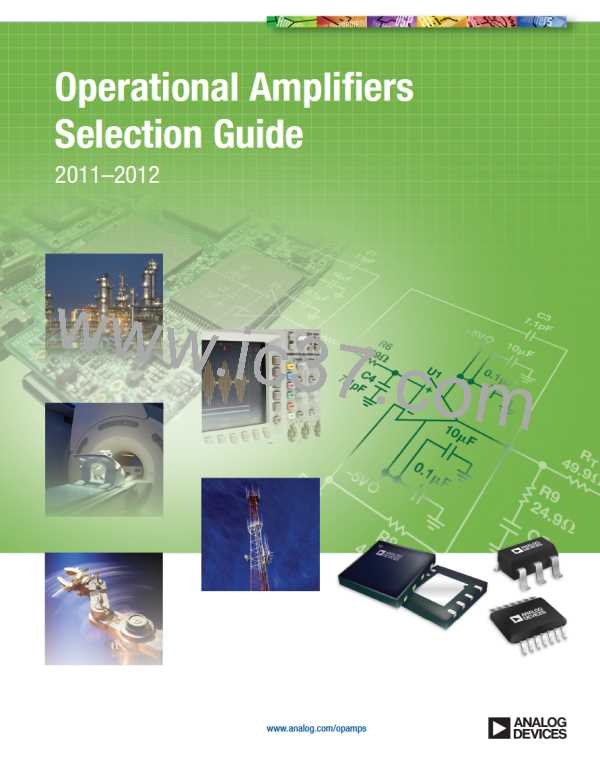Op Amp Glossary
Common-Mode Voltage Range (CMVR)
Open- Loop Gain (AVO)
Also known as input voltage range, CMVR is the allowable input voltage
The ratio of the output voltage to the input offset voltage between the two
range at both inputs before clipping or excessive nonlinearity is seen at the input pins. The result is expressed in dB. Gain is usually specified only at
output.
dc (AO), but for many applications, such as high speed amplifiers for video
and RF, the frequency dependence of gain is also important. For this reason
the open loop gain and phase response is published for each amplifier.
Common-Mode Rejection Ratio (CMRR)
The ratio of the common-mode voltage range (CMVR) to the change in the
input offset voltage (ΔVoOS) over this range. The result is expressed in dB.
CMRR (dB) = 20log (CMVR/ΔVOS)
Operating Supply Voltage Range
The supply voltage range that can be applied to an amplifier for which
it operates within specifications. Many applications implement op amp
circuits with balanced dual supplies, while other applications for energy
conservation or other reasons, use single-supply. For example, battery
power in automotive and marine equipment provides only a single polarity.
Even line-powered equipment, such as computers, may have only a single-
polarity built-in supply, furnishing +5 V or +12 V dc for the system, or
often as low as 1.8 V, with newer applications going even lower.
Full Power Bandwidth
The maximum frequency measured at unity gain for which the rated
output voltage can be obtained for a sinusoidal signal at rated load without
distortion due to slew rate limiting.
Gain Bandwidth Product (GBW)
The product of open-loop gain and bandwidth at a specific frequency.
Power Supply Rejection Ratio (PSRR)
The ratio of the change in power supply voltage to the change in input
offset voltage. The result is expressed in dB. PSRR = 20log (ΔVSY/ΔVOS)
Input Bias Current (IB)
The current at the input terminals.
Settling Time
Input Bias Current Drift
The amount of time required for an amplifier to settle to some predetermined
level of accuracy or percentage of output voltage after the application of a
step input.
The proportional change in input bias current vs. temperature over a
specified range of temperature.
Input Offset Current
The difference between the two input currents.
Slew Rate
The maximum rate of change of output voltage under large signal
condition. The result is usually expressed in V/µs.
Input Offset Current Drift
The ratio of input offset current change over a specified temperature range,
with the output held a constant voltage.
Supply Current
The current required from the supply voltage to operate the amplifier with
no load.
Input Offset Voltage Drift (TCVOS)
The ratio of change in input offset voltage to a change in temperature.
Small Signal Unity Gain Frequency
The frequency at which the open-loop gain is unity or 0 dB. This applies
only to signals under 200 mV. Due to slew rate limiting, it is not possible to
obtain large output voltage swings at high frequencies.
Offset Voltage (VOS)
The differential voltage needed across the op amp input terminals to obtain
zero output voltage. Offset voltage values range varies by process and
design technology:
•ꢀAuto-Zero Op Amps: <1 µV
•ꢀPrecision Op Amps: 50 µV to 500 µV
•ꢀBest Bipolar Op Amps: 10 µV to 25 µV
•ꢀBest JFET Iput Op Amps: 100 µV to 1000 µV
•ꢀBest Bipolar High Speed Op Amps: 100 µV to 2000 µV
•ꢀUntrimmed CMOS Op Amps: >2 mV
•ꢀDigiTrim® CMOS Op Amps: <100 µV to 1000 µV
Operational Amplifier Selection Guide
4
|

 ADI [ ADI ]
ADI [ ADI ]